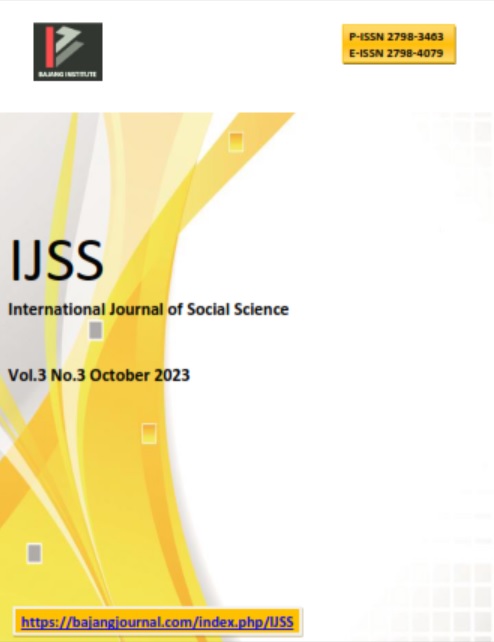SYMBOLIC INTERACTIONISM ON THE CREATIVE MESSAGE ART OF MENTAWAI TATTTOOS AS A SUBCULTURAL IDENTITY
DOI:
https://doi.org/10.53625/ijss.v3i3.1916Keywords:
Symbolic interactionism, Construction of social reality, Traditional Tattoos, Custom Tattoos, MentawaiAbstract
This research focuses on the interaction of the Mentawai people of Indonesia in communicating traditional Mentawai tattoo symbols, and how the construction of the meaning of these symbols in the young Mentawai generation as an effort to preserve traditional tattoo art culture in the midst of modern culture. Most young Mentawai generation spread throughout Indonesia has assimilated with modern culture by using modified creative content of Mentawai traditional tattoo symbols as their identity. This study uses symbolic interactionism theory and use a phenomenological method with a qualitative approach and a constructivist paradigm. The data collection technique uses in-depth interviews with the people who practice Mentawai tattoo culture. In this study, there were 3 informants who still practiced traditional Mentawai tattoos and 3 informants who were modifying Mentawai tattoo into creative content. Data analysis techniques perform horizonalization, clustering the invariant constituent into themes, individual textural and structural descriptions, composites, and synthesis. The study found that there was a change in the meaning of the Mentawai tattoo symbols in the creative messages of custom tattoos. Tattoos were used as a tool to communicate ethnic identity, social recognition, and professional identitiy, then tattoos norm have changed to aesthetics, tribal pride, self-identity, and self-expression of the love of art and traditional tattoos. The younger generation continously reconstructing the creative messages and meanings of Mentawai tattoos that adapt to modern culture. Conclusion: the change in the dominant Mentawai culture into a subculture is caused by a social movement making tattoos creatively by the younger generation as the identity of the Mentawai cultural tribe from traditional to custom tattoos
References
E. Hotson, “Kisah stigma sosial terhadap orang-orang bertato di seluruh dunia,” Jan. 21, 2020. https://www.bbc.com/indonesia/vert-cap-51172251 (accessed Sep. 10, 2023).
H. A. K. Olong, Tato, 1st ed. Yogyakarta: LKiS Yogyakarta, 2006.
S. W. Littlejohn and K. A. Foss, Teori Komunikas, 9th ed. Jakarta: Salemba Humanika, 2009.
B. Hegarty, “‘No Nation of Experts’: Kustom Tattooing and the Middle-Class Body in Post-Authoritarian Indonesia,” The Asia Pacific Journal of Anthropology, vol. 18, no. 2, pp. 135–148, Mar. 2017, doi: 10.1080/14442213.2016.1269833.
J. P. Williams and H. Copes, “‘How Edge Are You?’ Constructing Authentic Identities and Subcultural Boundaries in a Straightedge Internet Forum,” Symb Interact, vol. 28, no. 1, pp. 67–89, Feb. 2005, doi: 10.1525/si.2005.28.1.67.
S. Blackman, “Subculture Theory: An Historical and Contemporary Assessment of the Concept for Understanding Deviance,” Deviant Behav, vol. 35, no. 6, pp. 496–512, Jun. 2014, doi: 10.1080/01639625.2013.859049.
A. R. Rumbiati and Y. Y. Putra, “Konsep Diri pada Masyarakat Mentawai yang Memakai Tato,” RAP UNP, vol. 6, no. 2, pp. 114–125, Nov. 2015, doi: 10.24036/rapun.v6i2.6614.
I. Handani and S. Azeharie, “Analisis Semiotika Tato Tradisional Suku Mentawai,” Koneksi, vol. 3, no. 1, p. 49, Dec. 2019, doi: 10.24912/kn.v3i1.6144.
A. Muhid and W. E. Wahyudi, Interaksi Simbolik. Teori dan Aplikasi dalam Penelitian Pendidikan dan Psikologi, 1st ed. Malang: Madani, 2020.
G. H. Mead, Mind, Self, and Society: From the Standpoint of a Social Behaviorist. Chicago and London: The University of Chicago Press, 1934.
D. Ahmadi, “Interaksi Simbolik: Suatu Pengantar,” MediaTor, vol. 9, no. 2, pp. 301–316, Dec. 2008, Accessed: Sep. 10, 2023. [Online]. Available: https://ejournal.unisba.ac.id/index.php/mediator/article/view/1115
S. W. Littlejohn and K. A. Foss, Theories of Human Communication, 10th ed. Long Grove: Waveland Press, 2011.
Sugiyono, Metode Penelitian Pendidikan: Pendekatan Kuantitatif, Kualitatif, dan R&D. Bandung: Alfabeta, 2016.
J. W. Creswell and C. N. Poth, Qualitative Inquiry and Research Design Choosing Among Five Approaches. California: Sage Publications, 2016.
L. J. Moleong, Metodologi Penelitian Kualitatif. Bandung: PT Remaja Rosdakarya, 2012.
C. Moustakas, Phenomenological Research Methods. California: Sage Publications, Inc, 1994.
L. Saksono, Y. Rahman, S. I. Samsul, S. Surastya, and D. I. Julaikah, Dari Strukturalisme Sampai Postkolonialisme: Berbagai Pemikiran Tentang ideologi dan Kebudayaan. Surabaya: PT Revka Petra media, 2015.
P. L. Berger and T. Luckmann, The Social Construction of Reality: A Treatise in the Sociology of Knowledge. New York: Penguin Books, 1979.
Downloads
Published
How to Cite
Issue
Section
License
Copyright (c) 2023 Anita Rosana, Ahmad Sihabudin, Suraya Mansur, Irfan Fauzi

This work is licensed under a Creative Commons Attribution 4.0 International License.

















